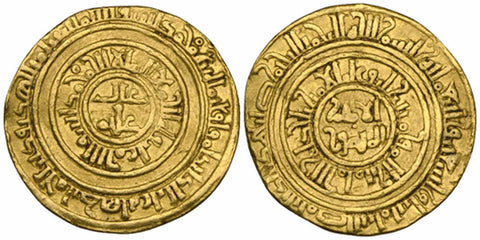Large Flan Cairo Egypt Islamic Gold Coin Mamluk Dinar (75) 1 AH/1350 AD al-Nasir Hassan First Reign
Description: A gold dinar coin from the Bahari Mamluk sultan Al Nasir Nasir Al-Din Abul Mahasin Hasan. The coin, which was minted in al-Qahira or Cairo the current capital of Egypt, was minted in (75)1 AH during Hassan's 1st reign which spanned the period 748-752 AH (1347-1351AD). The coin clearly shows the mint name and shows the number 1 of 751 the year of minting. A nice extremely fine coin with some strike weakness near the edge of both the obverse and reveres. The coin has very sharp calligraphy and a well centered strike. Please carefully review the photos as they are part and parcel of our description.
Date: Struck in 751 AH or 1350 AD.
Mint: al-Qahira or current day Cairo the capital of Egypt.
Size and Weight: This is a dinar weighing ~6 grams and is slightly off round measuring ~28x26 mm.
References: It is Album #944 it is listed in Balog as #319, and is Wilkes 996 (this is the exact coin shown in Wilkes' Catalog).
Provenance: See Wilkes' Islamic Coins & Their Values, Volume 1; The Medieval Period published by Spink, London in 2015 Page 94, coin # 996 for the same exact coin.
Condition: I would grade this coin as very fine or much better. The coin has some peripheral weakness, which can be seen in the photos. The coin itself is much better than the photos show with very well defined and legible calligraphy. The coin is a bit off round, which is common for ingot coins that were used based on weight instead of count. It has a few minor scratches, dings and wear commensurate with its circulated state. A definite quality and well documented coin worthy of a spot in your collection. Please see images for additional condition information.
Historic Perspective: The word Mamluks in Arabic means "owned", hence their nickname "Slave Kings". They succeeded the Ayyubids and ruled Egypt and Syria for about 250 years. They had been recruited by the Ayyubids and then, like the Turkish mercenaries of the Abbasid caliphs, had usurped power from their enfeebled masters. Unlike their predecessors, however, they were able to maintain their power, and they retained control of Egypt until the Ottoman conquest in 1517. Militarily formidable, they were also the first power to defeat the Mongols in open combat in 1260, at Ayn Jalut near Nazareth in Palestine.
The Mamluk sultans are usually divided into two dynasties, the Bahris (1250 - 1382 AD), chiefly Turks and Mongols, and the Burjis (1382 - 1517 AD), chiefly Circassians. These names arise from the location of the barracks of the Mamluks within the city of Cairo (Al Kahira). Those originating from the barracks on an island in the Nile are Bahari (sea dwellers) and those who were in the towers of the Cairo Citadel are the Burjis (the tower dwellers). The Bahri sultans were usually selected from a few chief families, but during Burji times there was scant respect for hereditary principle in the selection of rulers. Neither dynasty was able to exercise more than a limited power over the turbulent Mamluk soldiers. The sultans reigned, on average, less than seven years and usually met violent ends. In spite of the dangers that threatened the sultans at home, they usually conducted a vigorous foreign policy. They defeated the last of the Crusaders and repulsed the Mongol invasion of Syria. At times they held all Palestine and Syria and the holy places of Arabia. Even after the Ottomans occupied Egypt they wheeled quite a bit of power until Mohammad Ali massacred the last of them at the Cairo Citadel in the early 1800's.





